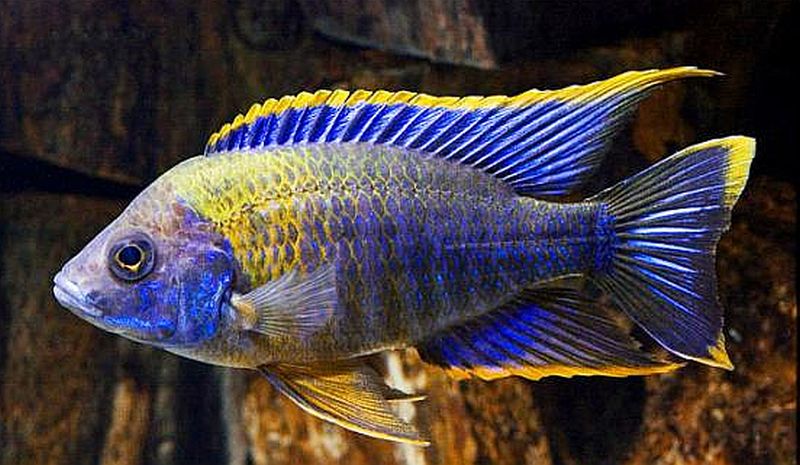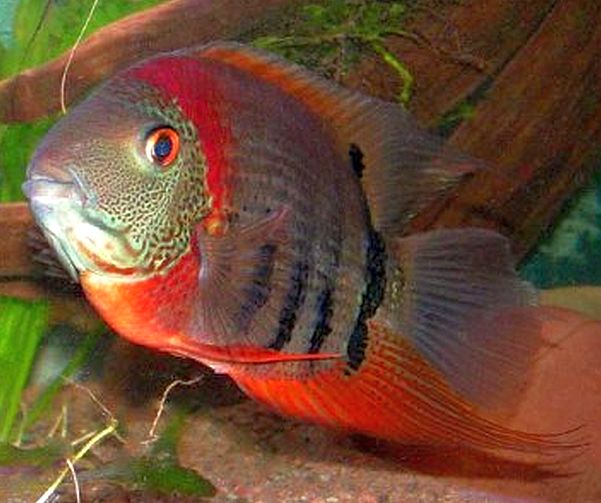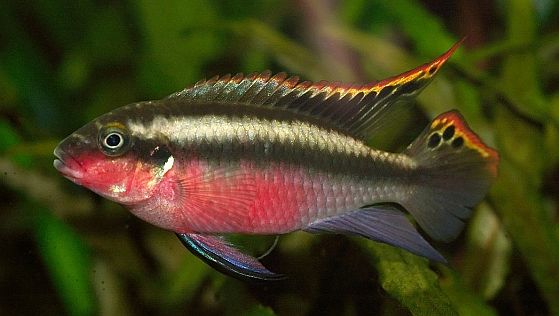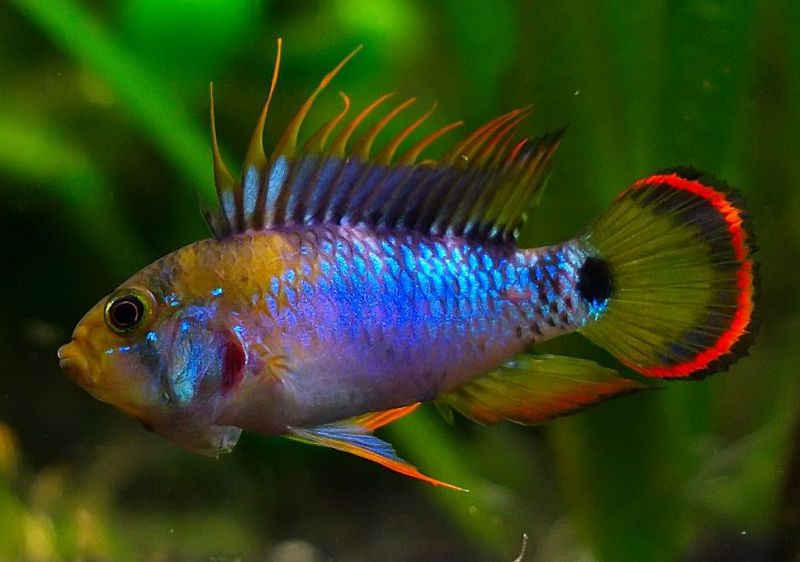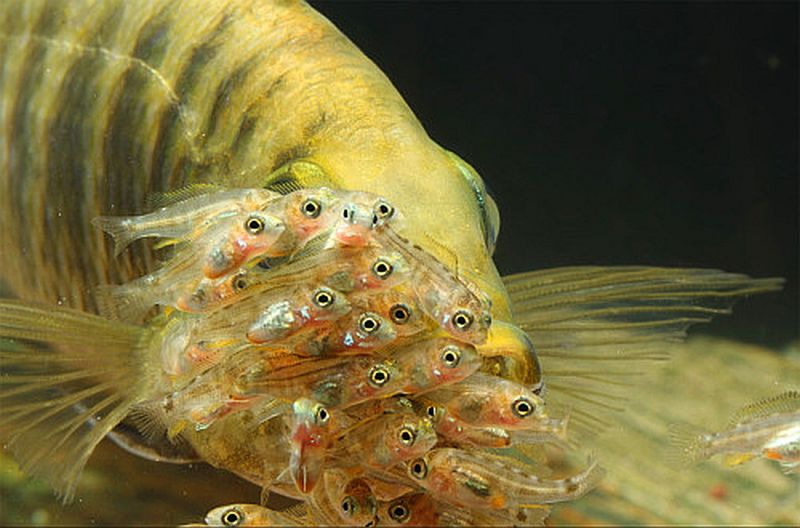Tropical fish keeping of Cichlids has become increasingly popular in the aquarium hobby over the years for a variety of reasons. Cichlids are colorful, attractive, active, fun to watch, easy to keep and are generally quite durable fish.
Most species are very active and many are very personable; greeting their keepers, begging for food and displaying intriguing behavior. These are just a few of the traits that make Cichlids a favorite of tropical fish keeping enthusiasts.
The Cichlid family offers tropical fish keepers a wide variety of body shapes, a vast range of sizes, and some of the most beautiful body pattern coloration found in the the aquarium hobby.
Because Cichlids come in a diverse variety of sizes, shapes and colors; they appeal to a wide swath of tropical fish keeping
enthusiast worldwide. Their popularity in part is due to their remarkable complex and sometimes ritualistic behavior as they perform their parental duties. Even though some varieties require specialized care, most are easy to house in an aquarium environment with a minimum of effort.
The geographic distribution of Cichlids worldwide is vast. In the aquarium hobby they are classified as either “New World” or “Old World” Cichlids. They are most diverse in South America and Africa.
Although there are no Cichlids native to North America, (north of Texas), the Far East, or Australia; in the New World they are found in areas of south Texas to Argentina, in South America.
Old World Cichlids are distributed throughout Africa and parts of the Middle East including the Islands of Madagascar, Sri Lanka and those along the southern coast of India which is home to several species. Africa alone is estimated to harbor at least 1,600 species.
Although there are no native Cichlid species north of Texas in North America, in recent years many varieties have been introduced into the waterways and canals of Florida either by accident or deliberately.
Ciclids are not found in higher elevations but they are found in almost all other types of freshwater throughout their geographic range. Lakes, ditches, canals, swamps, rice paddies and even mud puddles can hold Cichlids, and although most Cichlid species require warmer waters above 65 degrees and are shallow water dwellers, some species have been found in depths of over 300 feet in Lake Malawi and in the Congo River.
Many types of Cichlids make great aquarium pets. Some of the South American species such as Severum, Angelfish and the Dwarf Cichlids are relative peaceful and amicable and can be kept in a group. Others are mildly to extremely aggressive and should be kept in a single species tank.
Some Cichlids display unique characteristics like the Goby Cichlid, featherfins, Tropheus genus, and the shell dwellers. Others from the Rift Lakes in Africa are prized for the colors.
Size matters, and some African and South American Cichlids reach impressive proportions that are not suitable for tropical fish keeping. The Peacock Bass (Cichla ocellarus) of South America is popular as a game fish and reaches lengths exceeding 30 inches.
The Kreibensis (Pelvicachromis pulcher) from West Africa, the Dwarf cichlid (Papilochromis altispinosa) from South America, and
a few other tiny secretive species generically called “dwarf cichlids” make excellent aquarium candidates.
Some species like the Mbuna of Lake Malawi are herbivores and others like the Pike Cichlids of the Amazon are carnivores.
Of the hundreds of species of Cichlids that are available to tropical fish keeping enthusiasts, none are live bearers. All Cichlids are egg layers that provide some sort of parental care for their eggs and fry. With very few exceptions, most Cichlids are easy to breed.
Providing parental care is not the norm for most fish species but in the world of cichlids, the males will typically tend to their offspring.
Some species lay their eggs on plant leaves, rocks, logs, or on the substrate. Parental care for these types consists of fanning and guarding the eggs and then caring for the fry (wrigglers) until they are free swimming. This guardianship can last for weeks to months in an aquarium environment. For most species of substrate spawners, both parents take part in caring for their young.
Some species of Apistogramma are haremic. This is when several females lay their eggs in separate caves that are in the territory of a single male. Each female tends to her own young while the male protects the entire harem of caves from predators and other males.
Some Cichlids have unique spawning behaviors but few surpass the shell dwelling cichlids of Lake Tanganyika.
These cichlids lay their eggs inside an unused snail shell and the males, which are usually larger, stand guard at the entrance. Some males keep a “harem” of females, which are all in separate shells, in the territory which the he conscientiously guards.
Many species of Lake Malawi, Lake Victoria and some Lake Tanganyika cichlids are mouth brooders. Typically, the female will lay her eggs and then suck them into her mouth where the male then fertilizes them. The fertilized eggs remain in her mouth until the eggs hatch and sometimes even after that stage.
Mouth brooders are not limited to females. Some species are bi-parental mouth brooders and a few are male mouth brooders.
Some South American species lay their eggs on the substrate, guard them until they hatch and then mouth brood them until they can care for themselves.
Hundreds of species of Cichlids are currently available to tropical fish keeping enthusiasts and with few exceptions, most can be housed in an aquarium environment with a minimum of equipment in tanks ranging from 10 gallons to 500 gallons and up.
Although some species require specialized care and are not recommended for beginners, many others are easy to keep and breed.
Most all cichlids are devoted parents and watching a pair of rearing their young in your living room aquarium is a tough act to follow.


